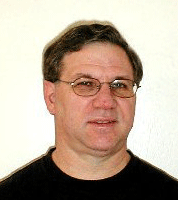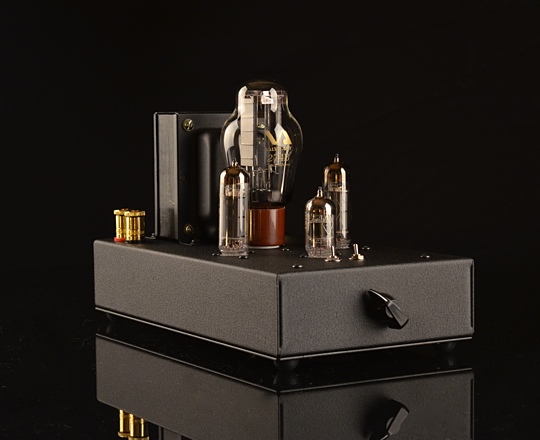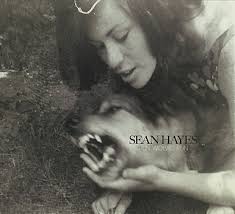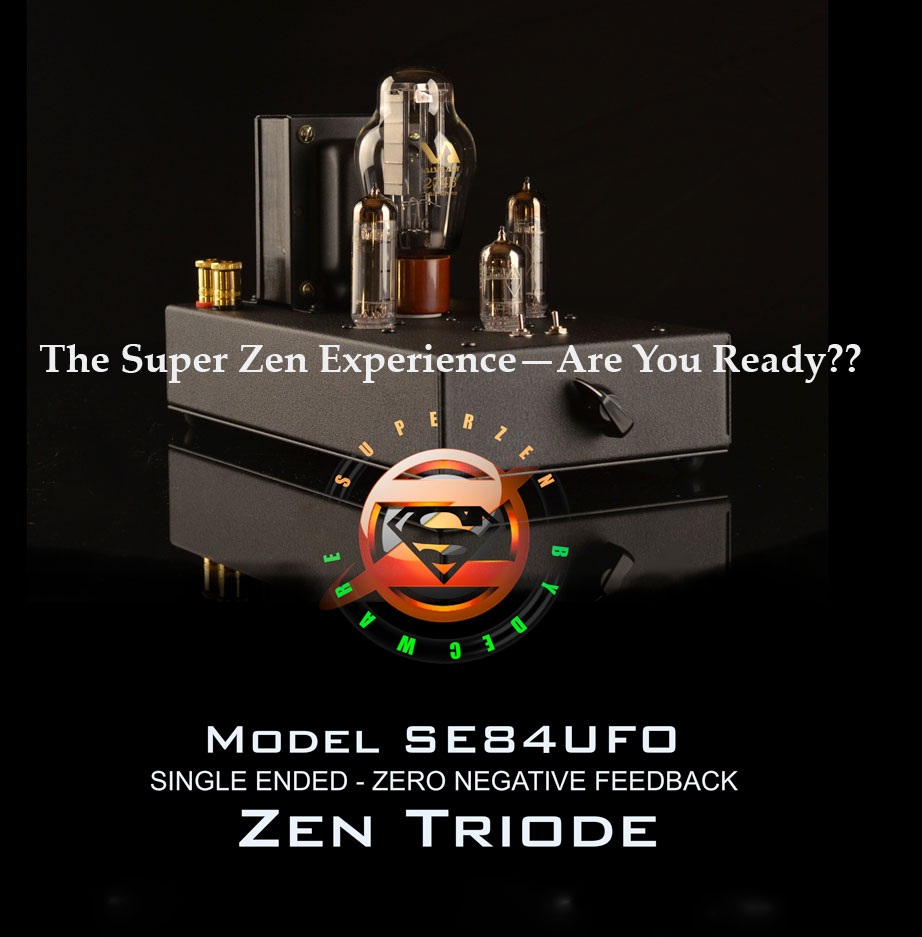Decware Super Zen Triode SE84UFO Amplifier
When one mindfully dwells in the present moment, one completely dissolves into whatever activity manifests. One becomes the activity. Most people have had peak experiences, which all involve being so totally involved with life that one’s sense of separateness dissolves into the experience. Very Zen. —Raphael Espericueta

I found this conception of “Zen” to be enlightening and having listened to Steve Deckert’s Decware “Super Zen Triode” (SZT) amplifiers, the “Super” may or may not be a bit of hyperbole, but the “Zen” descriptor makes sense to me.
Features and Setup
The Super Zen Triode amps are simple to set up and use. You basically plug in the 4 tubes and hook up the AC cord, input, and speaker cables. Then you are ready to set the 4 switches on the amplifier. The two at the rear select between 8 and 4 Ohms (one switch per channel); and the two front switches choose between the two pairs of stereo inputs and set the self-biasing input tube to either high or lower bias (right, no periodic playing with meters and probes to correct bias for tube aging!).
The nice thing is that all the switches can be operated while the amp is powered up. So one can A/B the effect of high or low input bias, and also the 8 Ohm vs the 4 Ohm speaker outputs. This makes it very easy to hear which positions sound best to you, the owner. The front panel volume control is convenient for use as either master volume or for limiting the volume from whatever volume controlled source you are using so that the amplifiers will have less of a chance of being overdriven. In this latter configuration, if you are using the amps as a mono pair, the volume controls can be used to fine-tune the L to R balance as well.

Another cool thing about the SZT amplifier is that virtually all of the tubes can be rolled to obtain a different custom voicing based on your particular listening preferences. The 6N1P input tube can be swapped for any tube in the 6922 family and the Russian 6P15P-EB output tubes can be swapped for EL84 tubes. Even the large 274B regulator tube may be swapped for another type (consult Steve Deckert). But realize that Guru Stevie D has done a lot of listening to these tubes to arrive at best sounding tube compliment for this amplifier—so improving on his choices may be more difficult than it might seem. Personally, I have zero complaints with the sound of these amplifiers so I did not experiment with other tube rolling options. In my view you might have better luck experimenting with your associated cable choices.
Have you ever heard of a tube amplifier coming with a lifetime warranty to the original owner? Well, outside of the tubes themselves, the Super Zen Triode amps come with such a warranty—courtesy of Super-Guru, Stevie D! That’s how confident Steve is that these amplifiers are very stable, have excellent parts quality, and will provide excellent service for a long, long time. And in fact, the present “Super” Zen model has been updated and refined over the course of the last 20 years—with copious feedback from thousands of happy owners and listeners along the way.
As to the system setup, I did try the SZT amps in 2 different systems to ensure a more well-rounded evaluation. In my Small-Room system they powered the WaveTouch Grand Teton SE speakers with my Lenovo G500 laptop feeding the PS Audio DirectStream DAC. Then downstairs in my large room I used the same Lenovo laptop feeding the Jolida Glass FX Tube DAC IIIW that in turn fed the SZT amps powering the Caintuck Audio Betsy open-baffle speakers. Neat & Sweet!
In this review, the bulk of my listening comments came from listening to SZT/Betsy system although the SZT/Grand Teton system has more bass extension and power, and more extended treble. But as we all know, the midrange is where 90 percent of the music resides (yes, that’s a hint for you, the reader to interpret).
The Super Zen Listening Experience
When I first hooked up a single SZT amp to the Caintuck Audio Betsy speakers, I was amazed at how dynamic the sound was and also how solid and articulate the bass was for such a low-power amplifier. Possibly what impressed me the most was the instantaneous speed of the fast transients that appeared out of silence with no overhang, just pure, transparent leading edges. For me, this was one characteristic where the SZT amp was a notch above just about every other amp I have heard.
 And when I tried the SZT with the WaveTouch Grand Teton SE speakers, not only was the bass more powerful and deeper, but with the SE’s AMT tweeter the upper highs were more extended and airy than with most other amps I have heard. I think the reason for that was Steve Deckert’s use of new custom-made Ultra-Fidelity Output “UFO” transformers that have a flatter and wider bandwidth than previous Decware output transformers—and most likely that of most other tube amplifiers on the market. I’m sure this helps with the perceived transient speed and impact the SZT amplifiers deliver in spades.
And when I tried the SZT with the WaveTouch Grand Teton SE speakers, not only was the bass more powerful and deeper, but with the SE’s AMT tweeter the upper highs were more extended and airy than with most other amps I have heard. I think the reason for that was Steve Deckert’s use of new custom-made Ultra-Fidelity Output “UFO” transformers that have a flatter and wider bandwidth than previous Decware output transformers—and most likely that of most other tube amplifiers on the market. I’m sure this helps with the perceived transient speed and impact the SZT amplifiers deliver in spades.
Deckert confided that surely the new UFO transformers contributed to my impression of transient speed but further, that the very simple circuit with only 2 resistors and one capacitor in the signal path, point-to-point wiring (part lead to part lead in some areas) and using the Russian 6N1P-EB output tubes (which are actually wide-band video tubes) all played a part in delivering the amazingly quick transients to the speakers. For sure the fewer parts the signal has to pass through on its way to your speakers, the less opportunity there is for the music to be degraded by phase shifts and other types of distortion.
Still, in this reviewer’s opinion, just 2 watts is not enough power if you are playing into a large room and your speakers are only 92.5dB efficient like my Betsy’s. So I asked Steve Deckert to send me another amp so I could strap the two for monophonic use (as a stereo pair). Apparently strapping the outputs in series results in 6 watts output per amp, and that did make an appreciable difference in their room-filling ability and headroom. But note that if you are using speakers with a sensitivity rating of more than 96 or 97dB/watt you may do well with only one SZT 2 watt stereo amplifier depending on the size of your room and how loud you like to play your music.
 Listening to Sean Hayes’ “Powerful Stuff” from his Run Wolves Run album (2010 Sean Hayes/ Ambient Egg 44185 04165) the power of the kickdrum’s beat caught my ear while Sean’s vocal was very natural and emotive. The accompanying guitar seemed like it was in the room, and the sustain and decay of the final guitar thwack was uncannily “right there.”
Listening to Sean Hayes’ “Powerful Stuff” from his Run Wolves Run album (2010 Sean Hayes/ Ambient Egg 44185 04165) the power of the kickdrum’s beat caught my ear while Sean’s vocal was very natural and emotive. The accompanying guitar seemed like it was in the room, and the sustain and decay of the final guitar thwack was uncannily “right there.”
Then on Hayes’ “So Down,” I could hear the individual strings vibrating while the guitar was being strummed! Lyric comprehension was outstanding on this album and that applies not only to Sean’s lead vocal but to the backing vocals as well.
 And listening to Eva Cassidy’s “Wade in the Water,” I could easily discern the hall echo and ambience around Eva’s powerful voice and could hear her every word and utterance clearly. The accompanying trumpet smacked of authenticity as it also does on my music files from The Best of Ella Fitzgerald & Louis Armstrong.
And listening to Eva Cassidy’s “Wade in the Water,” I could easily discern the hall echo and ambience around Eva’s powerful voice and could hear her every word and utterance clearly. The accompanying trumpet smacked of authenticity as it also does on my music files from The Best of Ella Fitzgerald & Louis Armstrong.
Speaking of which, on the song “Gee Baby Ain’t I Good to You” Ella’s vocal is pure honey, while in contrast, Armstrong’s voice displayed its unique gravelly character very well. And as I mentioned above his trumpet is brassy, sassy, and very true to life. Great stuff! Just to reiterate, the SZT amp truly excels at capturing the leading transient attack of vocals, instruments, and percussion—thus adding a lively and uncommonly potent jump factor to the music.
 Playing Ingrid Michaelson’s “Be Okay,” from the album of the same name (Cabin Records 90264 00210) the acoustic guitar was perfect in its tone and focus, and Ingrid’s vocal was pure Ingrid all the way. Also of note were the runs on stand-up bass, which were right on the money tonally—not the least bit off key or puffy as they can be with lesser amplifiers.
Playing Ingrid Michaelson’s “Be Okay,” from the album of the same name (Cabin Records 90264 00210) the acoustic guitar was perfect in its tone and focus, and Ingrid’s vocal was pure Ingrid all the way. Also of note were the runs on stand-up bass, which were right on the money tonally—not the least bit off key or puffy as they can be with lesser amplifiers.
I found the stereo imagery and soundstage dimensionality to be first rate with the SZT amps. They certainly have width, depth, and layering in spades. When first playing the amps my eyebrows raised when I heard just how dynamic these low-power amplifiers can sound—quite shocking really—yeah baby, yeah!
Caveats
My one real caveat with the Super Zen Triode amplifiers is that they are low power amps and as such will not drive all speakers to adequate volume levels for all listeners.
That being said, they worked very well with my Wavetouch Grand Teton SE speakers in my small room, and my Caintuck Audio Betsy speakers in my large room. I thought that the single stereo amp was a bit short on power (but useable) in both applications. Clipping manifested as a slight hardening of the sound on very LOUD power peaks, and as a general loss of clarity if a lot of instruments were playing at once.
After adding the second SZT amp, effectively boosting power output to 6 watts per channel, they played my speakers significantly louder without much (if any) clipping. My speakers are both in the 92+dB/watt efficient range. Steve Deckert told me that speakers that are above 96 or 97dB efficient will likely require only one stereo 2 watt/channel SZT amplifier to achieve satisfactory volume levels in small to medium size rooms. Based on my own experience, I would have to agree with Steve’s assessment—as long as we are not talking really LOUD rock concert levels.
Conclusion
I found the Super Zen Triode amps to be very well behaved, very low in noise, and their aural presentation is sheer joy to behold. I believe I can safely say that these amplifiers are definitely more transparent and true to life than most other amplifiers I have heard, including many at multiples of the SZT’s shamefully low price (even if you are buying a pair!).
That being said, Decware does charge extra for the optional Beeswax capacitors, stepped attenuators, and silver jumpers and Y-connectors if you are buying a mono pair. The price of the review pair of amps equipped with all the above options is $2,718—still inexpensive in the world of high-end audio, but not as inexpensive as I initially thought.
This is a very stable, time-proven amplifier that sounds magnificent and comes with a lifetime warranty for an inexplicably low price. The Super Zen Triode is the kind of amplifier that sounds so good and performs so well that I would recommend them to anyone who has speakers rated at 92dB/watt or higher. And if you have lower efficiency speakers, it may be well worth considering buying a higher efficiency model just so you can appreciate the adroit, superbly musical and finely nuanced performance of which these fine amplifiers are capable.
Heck, you could even use a Super Zen Triode amp in a second system. The only rub being that you may find that the resulting “second system” outperforms your expensive high-zoot main system…


frank alles
Manufacturer
DECWARE / High Fidelity Engineering Co.
75 S. Riverview Drive, East Peoria IL 61611 USA
Phone: (309) 822 5255
DECWARE Super Zen Triode SE84UFO Amplifier
Base Price: $995 each, USD
Price as Tested: $1,225 each with Beeswax caps and stepped attenuator
Price for Pair as Tested with Decware’s silver Y-connectors and silver jumpers: $2,718 USD
Product Highlights (from DECWARE):
- Hand Crafted directly by Decware – A notch above mass-produced retail.
- A signal path featuring a mere 2 resistors and 1 capacitor.
- Decware’s highly interleaved UFO output transformers made in the USA.
- Class A SET amplifier that can handle dips down to 1 ohm.
- 7 revisions spanning 16 years.
- Direct feedback from 6200 customers creates a highly evolved product.
- Cryo-treated film and foil beeswax capacitors 15 years in the making.
- Point-to-point wired with no circuit boards in our Zen Dream Shop.
- Designed by audio guru Steve Deckert.
- Built in USA with USA parts and labor.
- Not mass produced but rather lovingly crafted by some of the world’s best.
This amplifier requires no adjustments or maintenance other than changing tubes every couple years. It is a self biasing design and self balancing meaning even unmatched tubes can be used without ruining the sound. The SV83 (6P15P-EV) or EL84 output tubes wired in triode were chosen over 300B, 2A3, 45, and other triodes for having the best sound and imaging
For Full Features & Specs: http://www.decware.com/newsite/SE84CKC.html
Stereo Times Masthead
Publisher/Founder
Clement Perry
Editor
Dave Thomas
Senior Editors
Frank Alles, Mike Girardi, Russell Lichter, Terry London, Moreno Mitchell, Paul Szabady, Bill Wells, Mike Wright, and Stephen Yan,
Current Contributors
David Abramson, Tim Barrall, Dave Allison, Ron Cook, Lewis Dardick, John Hoffman, Dan Secula, Don Shaulis, Greg Simmons, Eric Teh, Greg Voth, Richard Willie, Ed Van Winkle, Rob Dockery, Richard Doran, and Daveed Turek
Site Management Clement Perry
Ad Designer: Martin Perry






Be the first to comment on: Decware Super Zen Triode SE84UFO Amplifier